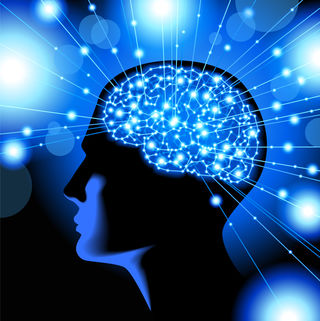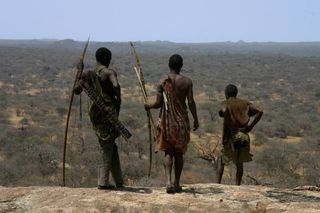Neuroscience
Hunter-gatherer Ancestry May Be Why Our Brains Need Exercise
Evolutionary neuroscience model explains why exercise is so good for your brain.
Posted June 27, 2017

Over the past decade, neuroscientists have identified that physical activity stimulates both neurogenesis (the birth of new neurons) and optimizes functional connectivity within the human brain via neuroplasticity. However, exactly why regular aerobic exercise produces so many neuroprotective benefits—and is the singular most effective way to bulk up gray matter brain volume and improve the integrity of your brain's white matter communication lines—has remained a mystery.
But there is some exciting news: A groundbreaking multi-disciplinary hypothesis posits that our hunter-gatherer ancestors may have inadvertently hardwired our brains to thrive on regular exercise. The June 2017 paper, "Adaptive Capacity: An Evolutionary Neuroscience Model Linking Exercise, Cognition, and Brain Health," was recently published online ahead of print in the journal Trends in Neuroscience.
This study was written by two researchers from the University of Arizona—anthropologist David Raichlen and UA psychologist Gene Alexander, who run an ongoing research program on exercise and the brain. Their radical new evolutionary neuroscience hypothesis is called the "adaptive capacity model" (ACM). The authors write, "From an evolutionary neuroscience perspective, physical activity stresses brain function because of the cognitively demanding foraging context in which our ancestors engaged in aerobic physical activity."
In December 2016, I reported on previous findings by Raichlen and Alexander in a Psychology Today blog post, "Runners' Brains May Develop Greater Connectivity." This post was inspired by their discovery that running improved brain connectivity in ways similar to practicing complex tasks such as playing a musical instrument.
Across the board, the UA researchers found that runners showed greater functional connectivity between various brain regions and the prefrontal cortex (PFC). They also found that endurance running appeared to engage multiple cognitive actions, including multi-tasking, planning, inhibition, monitoring, and attentional switching. But, Raichlen and Alexander didn't have a paradigm of thought to explain why this was happening, which led them to explore an evolutionary neuroscience-based explanation for this phenomenon.
In their latest study, the UA exercise-brain researchers set out to answer two fundamental questions: First, what are the proximate and ultimate mechanisms underlying age-related brain atrophy. Second, how do lifestyle changes influence the trajectory of healthy and pathological aging? From a public health perspective, these queries were driven by the fact that the epidemic of sedentarism (too much sitting) may be causing people's brains to atrophy and contribute to preventable cognitive decline.
Raichlen and Alexander's new evolutionary neuroscience model is based on the idea that about 2 million years ago humans transitioned from a relatively sedentary apelike existence (which didn’t involve chasing prey for long distances) to a more aerobic exercise based hunter-gatherer lifestyle. Additionally, we began to engage in much more complex foraging tasks that required more cognitive capacity and cardiorespiratory stamina.
Raichlen, who is associate professor in the UA School of Anthropology, described his thought process in a statement: "It's very odd to think that moving your body should affect your brain in this way—that exercise should have some beneficial impact on brain structure and function—but if you start thinking about it from an evolutionary perspective, you can start to piece together why that system would adaptively respond to exercise challenges and stresses.”
Gene Alexander, a UA professor of psychology, psychiatry, neuroscience and physiological sciences, added:
"Our evolutionary history suggests that we are, fundamentally, cognitively engaged endurance athletes and that if we don't remain active we're going to have this loss of capacity in response to that. So there really may be a mismatch between our relatively sedentary lifestyles of today and how we evolved.
What we're proposing is, if you're not sufficiently engaged in this kind of cognitively challenging aerobic activity, then this may be responsible for what we often see as healthy brain aging, where people start to show some diminished cognitive abilities. So the natural aging process might really be part of a reduced capacity in response to not being engaged enough."
According to Raichlen, who is both an avid runner and running expert: "Our organ systems adapt to the stresses they undergo. For example, if you engage in exercise, your cardiovascular system has to adapt to expand capacity, be it through enlarging your heart or increasing your vasculature, and that takes energy. So if you're not challenging it in that way—if you're not engaging in aerobic exercise—to save energy, your body simply reduces that capacity." ("Reduced capacity” refers to the detrimental impact of sedentarism to various organ systems throughout the body when someone doesn't exercise regularly.)

When I first read about the new evolutionary neuroscience ACM theory this morning, I was immediately reminded of Raichlen's 2016 study with anthropologist Brian Wood of Yale University and Herman Pontzer of Hunter College, "Physical Activity Patterns and Biomarkers of Cardiovascular Disease Risk in Hunter-Gatherers."
This study examined the daily exercise habits of one of the last remaining hunter-gatherer societies on the planet—the Hadza of East Africa—and identified a strong correlation between moderate-to-vigorous physical activity (MVPA) and a lower risk of cardiovascular disease. From an evolutionary perspective, these findings dovetail with the latest theory on the brain benefits of regular aerobic exercise.
Alexander and Raichlen hope that their new "adaptive capacity" model will inspire more advanced research on the interplay between evolution, exercise, and the brain. Having a better understanding of the exercise-brain connection could help experts develop more finely-tuned and effective interventions for age-related cognitive decline and neurodegenerative diseases such as Alzheimer's. There's also the possibility that the new ACM model could facilitate pinpointing the ideal prescriptive dose of aerobic intensity and exercise duration necessary to optimize brain structure and cognitive function across the human lifespan.
"This evolutionary neuroscience perspective is something that's been generally lacking in the field," Alexander concluded. "And we think this might be helpful to advance research and help develop some new specific hypotheses and ways to identify more universally effective interventions that could be helpful to everyone." I agree.
References
David A. Raichlen, Gene E. Alexander. Adaptive Capacity: An Evolutionary Neuroscience Model Linking Exercise, Cognition, and Brain Health. Trends in Neurosciences, 2017; 40 (7): 408 DOI: 10.1016/j.tins.2017.05.001
David A. Raichlen, Pradyumna K. Bharadwaj, Megan C. Fitzhugh, Kari A. Haws, Gabrielle-Ann Torre, Theodore P. Trouard, Gene E. Alexander. Differences in Resting State Functional Connectivity between Young Adult Endurance Athletes and Healthy Controls. Frontiers in Human Neuroscience, 2016; 10 DOI: 10.3389/fnhum.2016.00610
Raichlen, D. A., Pontzer, H., Harris, J. A., Mabulla, A. Z. P., Marlowe, F. W., Josh Snodgrass, J., Eick, G., Colette Berbesque, J., Sancilio, A. and Wood, B. M. (2016), Physical activity patterns and biomarkers of cardiovascular disease risk in hunter-gatherers. Am. J. Hum. Biol.. DOI: 10.1002/ajhb.22919




